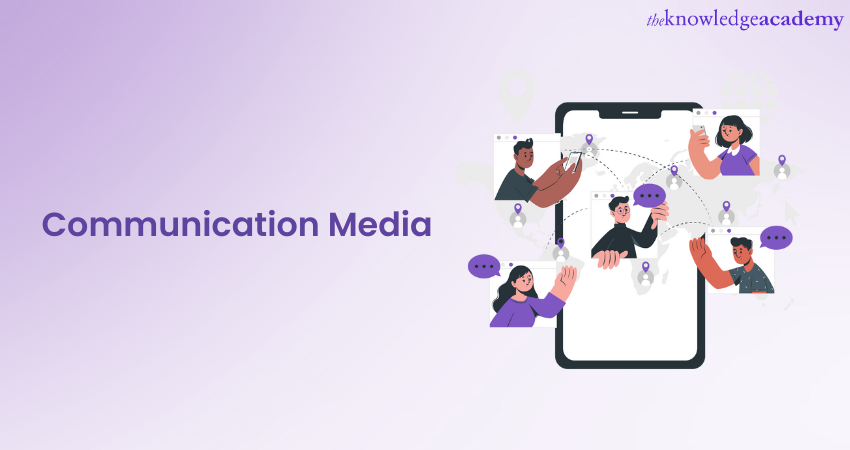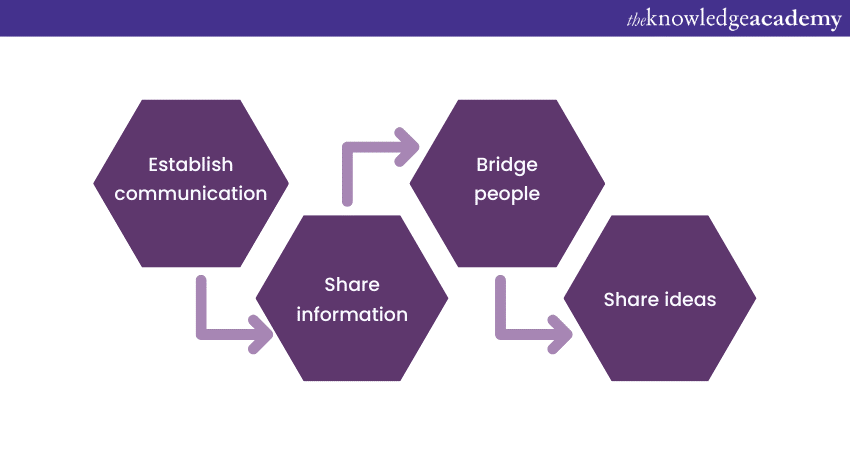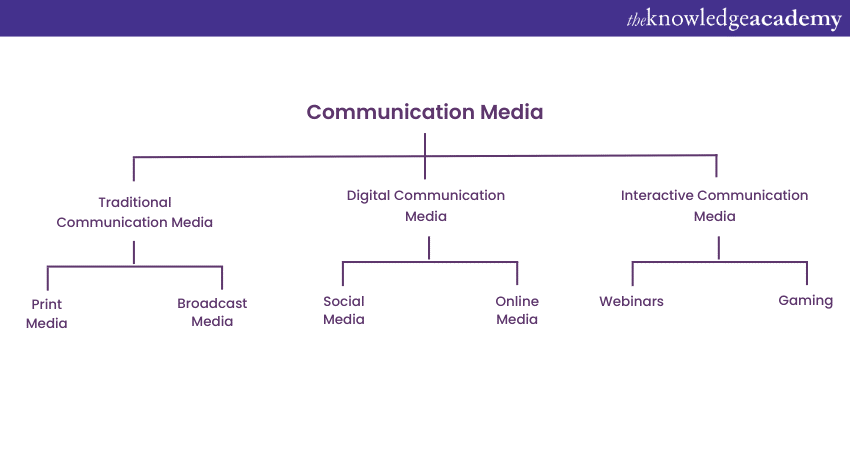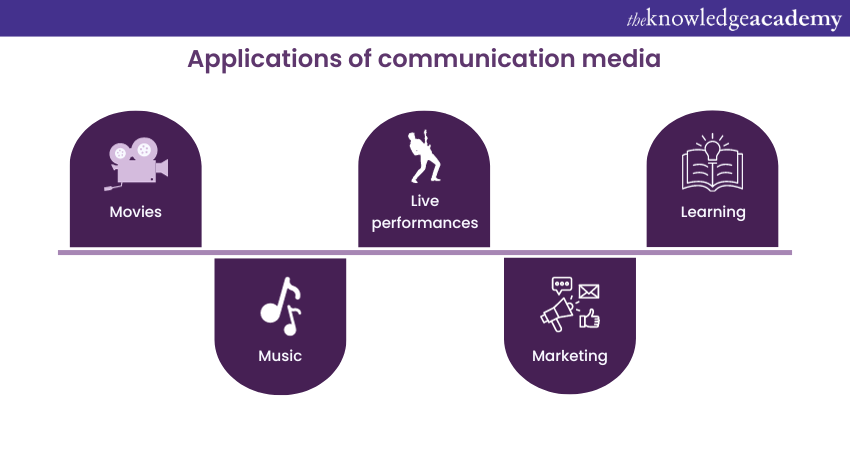We may not have the course you’re looking for. If you enquire or give us a call on 01344203999 and speak to our training experts, we may still be able to help with your training requirements.
Training Outcomes Within Your Budget!
We ensure quality, budget-alignment, and timely delivery by our expert instructors.

When it comes to modern Communication, individuals and businesses alike face numerous challenges. From e-mail to social media to video conferencing, efficiently navigating these channels can be daunting. However, by gaining a deeper understanding of Communication Media, we can harness their power to streamline Communication processes and foster stronger connections.
If you want to learn about Communication Media and its various types and applications, this blog is for you. Let's dive in!
Table of Contents
1) What is Communication Media?
2) Various types of Communication Media
3) Applications of Communication Media
4) Examples of Communication Media
5) Conclusion
What is Communication Media?
Communication Media refers to the various channels or means through which information is transmitted, shared, and received. It includes a broad range of platforms and tools that enable communication between individuals, groups, and organisations. Here are some of the key objectives of this form of Media:

a) Connecting people: Communication Media bridges the geographical gaps, allowing individuals from different locations to connect, interact, and build relationships.
b) Disseminating information: Communication Media serves as a powerful tool for sharing news, knowledge, and insights, reaching a wide audience and keeping people informed.
c) Facilitating the exchange of ideas: Communication Media creates platforms and spaces where ideas can be shared, discussed, and debated. As a result, it fosters innovation and intellectual growth.
From traditional methods to modern digital platforms, Communication Media has evolved significantly, revolutionising the way we interact, collaborate, and share knowledge.

Various types of Communication Media
Communication Media has played a significant role in delivering information, entertainment, and connecting people across the globe. From traditional forms to digital platforms, the evolution of Communication Media has revolutionised the way we exchange ideas, disseminate news, and engage with diverse audiences.
Here, we will analyse its rich landscape exploring its different types and their unique characteristics. By understanding the wide range of mediums available, we can appreciate their immense impact on society and how they shape our interactions and experiences.Let’s explore the different types of Communication Media:

Verbal Media Communication
When Communication is performed using words, be it written or via spoken, it is considered verbal Communication. It can be classified into two different types, and let’s explore them below:
a) Oral Communication:
Any Communication that happens via speaking can be considered oral Communication. Whether it's two people having a conversation on the phone or debating on a stage, it all comes under oral Communication. It is an extremely effective form of Communication as there will be very few misunderstandings when compared to others. Other than that, you get feedback from your listener instantaneously without any delays. Let’s explore some examples of oral Communication:
1) Telephone: Telephonic Communication is a form of oral Communication that has many advantages. Both the speaker and listener don’t have to be present in the same location, and all you need is your voice and tone to pass information.
2) Presentation: Presentations are one of the most popular forms of oral Communication, used almost every day. It is typically done in a professional or formal setting with the goal of sharing knowledge, raising awareness or presenting ideas. The goal of the presenter is to convey their ideas on a specific topic to the audience in a clear and concise manner.
3) Public speech: Public speech is yet another popular form of oral Communication, and unlike presentations, it can happen both in a formal as well as informal settings. From entertainers to politicians, public speech is used by many people across the world. It is a very powerful tool as it has the power to shape human lives forever.
4) Interview: In general, interviews are performed in a formal setting with a few exceptions. This method of Communication is used for hiring talents, and it involves an interview panel of one to five members interviewing a person. Candidates are evaluated based on many metrics like Communication, technical knowledge and problem-solving abilities.
5) Meeting: Meeting is another popular form of Communication and generally involves at least two or more persons. Similar to a speaker in a public speech, most meetings have a head who addresses the participants to deliver key information. It can happen both in formal and informal settings. The meetings happen in a formal setting and will involve written Communication, such as documentation or reports.
b) Written Communication:
Written Communication is another type of Verbal Communication. Although they are both the two sides of the same coin, they differ from each other extremely when it comes to how the information is passed through. This form of Communication is very effective in some areas, as it can ensure clarity and accuracy. It has many advantages compared to oral communication as it is dictated by the speaker. In written Communication, the reader can read through the subject at their own pace and can take breaks. However, it could greatly benefit when used along with oral communication as the combination of both can give more credibility. Here are a few examples of written communication:
1) E-mails: Although e-mails have been around for a couple of decades, they are still the most popular and preferred method of Communication in the professional world. Whether it’s Communication with your peers or negotiating business deals with your clients, e-mails are the go-to choice. You can use it to send reports, job applications, and business proposals.
2) Proposals: Business proposals play a very important role in reshaping the future. It is generally used to get projects or secure capital and investments. A well-drafted business proposal has to clearly describe the goal as well as the processes involved to increase their chances of success.
3) Reports: When it comes to written Communication, reports are at the top of the chart. They are generally used to describe the tasks performed as well as their outcome. They play a key role in bridging the link between an organisation and its clients as they can be used to understand all the business activities.
4) Brochures: In written Communication, brochures are generally used for advertisement purposes. A brochure could be anything from a pamphlet or a template which contains key information about a product or an organisation’s service. It is one of the simplest yet effective forms of Communication.
Non-verbal Media Communication
Non-verbal Media Communication, as the name suggests, is performed without using any words, be it oral or written. The information is generally passed via non-verbal mediums, and let’s explore some of them below:
1) Body language: Body language is one of the most underrated forms of communication that we perform almost every day. The way a person reacts can speak volumes, and Some of the most successful persons are experts in body language. That’s why it is extremely important.
2) Gestures: In a world dominated by emojis, gestures still play a vital role. Using a simple positive gesture like a thumbs-up could play a massive role in your Communication and help you leave a long-lasting impact.
3) Touch: Touch is another effective form of communication used by humans and animals alike. You can effectively use touch as a mechanism for positive reinforcement. However, not everyone is fond of touch, so check if they are fine with it.
4) Silence: Believe it or not, silence is a method of Communication, and we all use it without even realising it. From paying respects to expressing sadness, silence is a perfect tool for Communication.
5) Proximity: Proximity can be used to express your bond and the respect you have for someone. At the end of the day, we are all social animals, and we can often see how animals express their affection using proximity. You can express your ideas and emotions even with proximity. Standing or staying close to someone can be used to express their bond and respect. At the same time, staying far or standing away from someone can be used to express discomfort.
Enhance your business Communication skills and achieve professional success with our Business Communication Training. Sign up now!
Applications of Communication Media
From learning to entertainment, the applications are vast and diverse. It helps enrich our lives by transforming various industries. Here are some notable applications:

Communication Media in entertainment
Communication Media plays a crucial role in the world of entertainment, providing engaging and immersive experiences. Here are some of its key aspects:
a) Film and television: Film and television platforms deliver captivating storytelling, visual effects, and memorable performances.
b) Music and streaming: Music platforms and streaming services offer a broad range of music genres and on-demand entertainment.
c) Live events and performances: Live events and performances create shared experiences, connecting audiences through entertainment and art.
d) Online gaming and esports: Online gaming and esports provide interactive and competitive entertainment for gamers worldwide.
e) Social media influence: As mentioned earlier, social media platforms enable influencers to shape and engage with entertainment trends and fandoms.
Communication Media in marketing
Effective Communication Media plays a vital role in the field of marketing, enabling brands to connect with their target audiences. Here are some of its key aspects:
a) Influencer marketing: Influencer marketing harnesses the power of social media influencers to expand the visibility of the brand and engage with a wider audience.
b) Content marketing: Content marketing strategies involve creating valuable and relevant content to attract, educate, and engage potential customers.
Communication Media in education
It plays a significant role in the field of education, transforming the way we learn and acquire knowledge. Here are some of its key aspects:
a) E-Learning platforms: E-learning platforms provide flexible and accessible educational resources. It offers interactive courses, tutorials, and assessments, respectively.
b) Podcasts: Podcasts offer an audio-based medium for educational content. This allows learners to access informative discussions and expert insights.
Master the art of effective Communication and propel your career to new heights with our comprehensive Effective Communication Skills Training. Sign up now!
Examples of Communication Media
Now that we’ve learned the applications of Communication Media. Let’s take a look at some of its examples:
Print media
Print media has been a fundamental form of Communication Media for centuries, providing valuable information, news, and engaging content to readers. It includes newspapers, brochures and books.
Broadcast media
Broadcast media has revolutionised how information and entertainment reach the masses. Television and radio are some examples of broadcast media
Digital Communication Media
Digital Communication Media have revolutionised the way we connect, communicate, and consume information. These platforms offer a multitude of opportunities for interaction, collaboration, and entertainment.
Interactive Communication Media
This avenue has revolutionised the way we engage and participate in digital platforms. The dynamic tools used enable real-time interaction, collaboration, and immersive experiences.
Conclusion
We hope you read and understand everything about Communication Media and its different types. This medium has revolutionised connectivity, information sharing, and engagement across industries. It plays a vital role in marketing, education, and entertainment, offering amplified reach, audience engagement, and expanded learning opportunities. Without a doubt, it is paving the way for a promising future.
Enhance your Communication skills today and unlock your full potential with our Communication Skills Training Courses - Sign up now!
Frequently Asked Questions

Analysing engagement stemming from your Communication Media involves gauging delivery rates, open rates, and click-through rates. These metrics offer valuable insights into the recipients, their interaction levels, and the extent of engagement with your messages.

Adapting Communication strategies to the ever-evolving media landscape presents both challenges and opportunities. The rapid proliferation of Communication Media demands agility in reaching diverse audiences across various platforms. Challenges include staying updated with emerging technologies and navigating the saturation of information.

The Knowledge Academy takes global learning to new heights, offering over 30,000 online courses across 490+ locations in 220 countries. This expansive reach ensures accessibility and convenience for learners worldwide.
Alongside our diverse Online Course Catalogue, encompassing 17 major categories, we go the extra mile by providing a plethora of free educational Online Resources like News updates, Blogs, videos, webinars, and interview questions. Tailoring learning experiences further, professionals can maximise value with customisable Course Bundles of TKA.

The Knowledge Academy’s Knowledge Pass, a prepaid voucher, adds another layer of flexibility, allowing course bookings over a 12-month period. Join us on a journey where education knows no bounds.

The Knowledge Academy offers various Communications Skills Courses, including Assertivenes Skills Training, Effective Communication Skills, Business Communication Course and more. These courses cater to different skill levels, providing comprehensive insights into the 12 Essential Company Secretary Skills.
Our Business Skills Blogs cover a range of topics related to Communication Media, offering valuable resources, best practices, and industry insights. Whether you are a beginner or looking to advance your Business Skills, The Knowledge Academy's diverse courses and informative blogs have you covered.
Upcoming Business Skills Resources Batches & Dates
Date
 Public Speaking Course
Public Speaking Course
Fri 28th Jun 2024
Fri 9th Aug 2024
Fri 25th Oct 2024
Fri 27th Dec 2024







 Top Rated Course
Top Rated Course


 If you wish to make any changes to your course, please
If you wish to make any changes to your course, please


